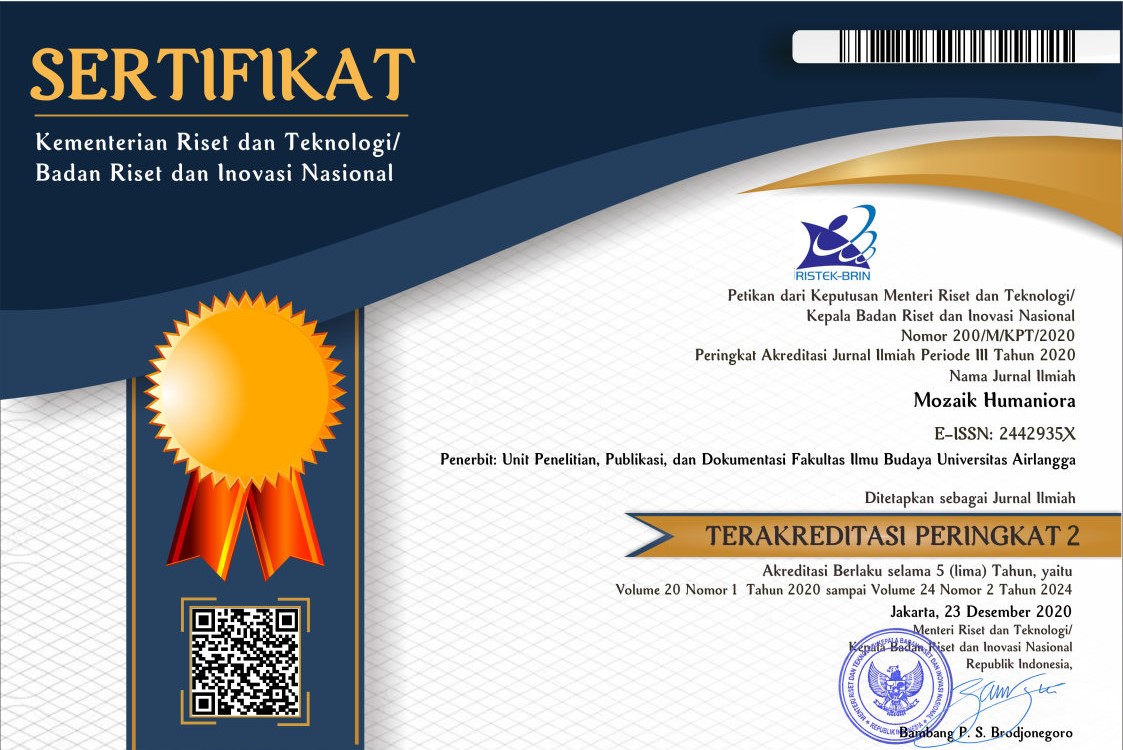Compounding in the Name of Animal Found in Rote Language of the Dengka Dialect
Downloads
Abstract
The title of this research is compounding in the name of animal found in Rote language of the Dengka Dialect. The purpose of this research are to discover and to describe how the compounding process in the name of animal found in Rote language of the Dengka Dialect and how the structure of compounding in the name of animal found in Rote language of the Dengka Dialect. The compounding process found in the name of animal are in fowl, unfowl, and the animal of under the water. Rote language was categorized of the family of Centre Malay Polynesia and as the agglutination language. It is consist of eighteen variation dialects, namely: Termanu, Korbafo, Landu, Ringgou, Oepao, Bilba, Diu, Lelenuk, Bokai, Talae, Keka, Ba'a, Lelain, Dengka, Oenale, Dela, Tii dan Lole. One of dialects that will be analized its compounding process is Dengka dialect. The research method used is descriptive qualitative. The approach theory used to analyse the data based on the perspective of Katamba and Muslich. The structure of compound word in the name of animal found in Rote language of the Dengka dialect consists of two and three lexemes that has the same categorized and does not the same categorized. The data are obtained by using observation and interlocution method. Meanwhile the collected data techniques by using the techniques are covert in observation and interlocution methods. The techniques are covert in observation method namely: tap conversation technique, observe in conversation technique, free observe in conversation technique, writing and recording technique. The techniques are covert in interlocution method namely: stimulus technique, direct interview technique, indirect interview technique, writing and recording technique. All data were gotten from the informant. The result of data analyzed show that the compound word found in the name of animal dominated of endocentric compound. The structure of compound word construct of two and three lexemes, namely: [N+N]→[N], [N+ADJ]→[N] and [N]+[N]+[N]→[N], The compound word in the Dengka dialect was categorized as strong and permanent compound. The compound words are dominated of compound noun types. The types of compound word that found are tatpurusa and karmadharaya compound.
Aronoff, Mark. 1979. "A Reply to Moody”. Glosa, Vol. XIII, No. 1
Booij, Geert. 2007. The Grammar of Word: An Introduction to Morphology: Oxford University Press
Comrie, Bernard. 1981. Language Universals and Linguistics Typology. 2nd edition. Chicago: Univercity of Chicago Press
Grimes, E Charles, dkk. 1997. A Guide to the People and Languages of Nusa Tenggara. Kupang: ArthaWacana Press
Katamba, Francis. 1993. Morphology: The Macmillan Press LTD
Loe, Efron, Erwin, Yohanis. 2012. Tesis. Sistim Pemajemukan Bahasa Rote Dialek Dengka. Kupang: Program Studi Linguistik, Program Pascasarjana. Universitas Nusa Cendana.
Loe, Efron, Erwin, Yohanis. 2018. Prociding. Methapor Compound Found in The Name of Animal in The Rote Language of The Dengka Dialect. Bandung. ICOLLITE II UPI.
Muslich, Masnur. 2008. Tata Bentuk Bahasa Indonesia: Kajian ke Arah Tata Bahasa Deskriptif. Jakarta: PT Bumi Aksara
Manafe, D.P. 1884. Akan Bahasa Rotti. Artikel
Scalise, Sergio.1984. Generative Morphology. Dodrecht-Holland/Cinnammision- U.S.A: Foris Publication.

Mozaik Humaniora is licensed under a Creative Commons Attribution-ShareAlike 4.0 International License. Both authors and Mozaik Humaniora agree with the following attribution of journal:
1. Copyright of this journal is possession of Author, by the knowledge of the Editorial Board and Journal Manager, while the moral right of the publication belongs to the author.
2. The journal allows the author(s) to retain publishing rights without restrictions
3. The legal formal aspect of journal publication accessibility refers to Creative Commons Attribution Share-Alike (CC BY-SA).
4. The Creative Commons Attribution Share-Alike (CC BY-SA) license allows re-distribution and re-use of a licensed work on the conditions that the creator is appropriately credited and that any derivative work is made available under "the same, similar or a compatible license”. Other than the conditions mentioned above, the editorial board is not responsible for copyright violation.


















